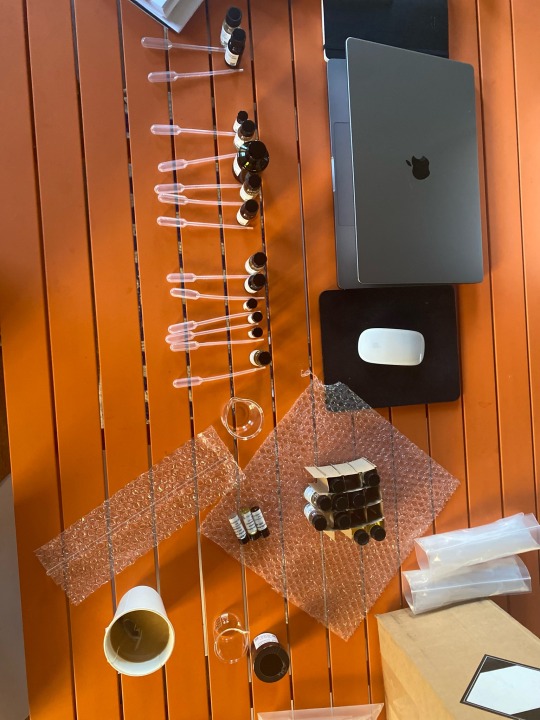#Olfaction
Text
petrichor
a distinctive scent, usually described as earthy, pleasant, or sweet, produced by rainfall on very dry ground.
Petrichor is an uncommon word used in mineral chemistry or geochemistry to describe the pleasant scent of rain falling on very dry ground. Petrichor is a compound of the Greek nouns pétrā “rock, stone” (as in petroleum “rock oil”) and īchṓr, the juice or liquid—not blood!—that flows in the veins of the Olympian gods. About 60 percent of ancient Greek words have no satisfactory etymology; īchṓr is one of them. Petrichor was coined by two Australian chemists, Isabel “Joy” Bear and Richard Grenfell Thomas, in 1964.
—https://www.dictionary.com/browse/petrichor
#quote#word#language#rain#petrichor#chemistry#etymology#minerals#mineral chemistry#scent#smell#olfactory#aromachology#olfaction#geology#water#geochemistry
219 notes
·
View notes
Text
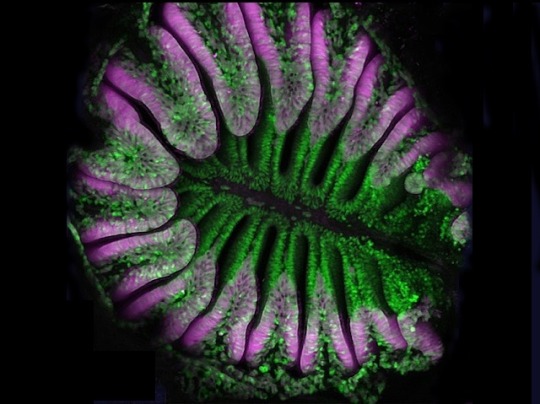
Equipped to Smell
Regulation by a transcription factor called Foxj1 underlies the molecular signals for development and differentiation of olfactory receptor neurons and their hair-like non-motile cilia vital for a vertebrate's sense of smell
Read the published research article here
Image from work by Dheeraj Rayamajhi, Mert Ege and Kirill Ukhanov, and colleagues
Institute of Molecular and Cell Biology, Agency for Science, Technology and Research, Singapore and Department of Clinical and Molecular Medicine, Norwegian University of Science and Technology, Trondheim, Norway
Image originally published with a Creative Commons Attribution 4.0 International (CC BY 4.0)
Published in PLOS Biology, January 2024
You can also follow BPoD on Instagram, Twitter and Facebook
7 notes
·
View notes
Text

Sleeps in the desert, smells like Tahitian monoi
3 notes
·
View notes
Text

Olfactive Stéréophonique by BYREDO
Olfactive Stéréophonique is an experimental and revolutionary fragrance diffuser collaboration that uses speaker design theory and scent to evoke the meditative effects of ritualistic practice and enhance a listening space.
The process is simple: sit comfortably with a high-fidelity sound system and select disks that set the tone for that moment or take you on a voyage that you’ll return from transformed. It’s a multi-sensory experience, one where all of the elements should be considered and where setting and scent is critical.
2 notes
·
View notes
Text
Interesting Papers for Week 29, 2022
Dynamic decision policy reconfiguration under outcome uncertainty. Bond, K., Dunovan, K., Porter, A., Rubin, J. E., & Verstynen, T. (2021). eLife, 10, e65540.
Sex differences in learning from exploration. Chen, C. S., Knep, E., Han, A., Ebitz, R. B., & Grissom, N. M. (2021). eLife, 10, e69748.
Rewarding cognitive effort increases the intrinsic value of mental labor. Clay, G., Mlynski, C., Korb, F. M., Goschke, T., & Job, V. (2022). Proceedings of the National Academy of Sciences, 119(5), e2111785119.
Hierarchical and nonhierarchical features of the mouse visual cortical network. D’Souza, R. D., Wang, Q., Ji, W., Meier, A. M., Kennedy, H., Knoblauch, K., & Burkhalter, A. (2022). Nature Communications, 13, 503.
Neurons as will and representation. Fried, I. (2022). Nature Reviews Neuroscience, 23(2), 104–114.
Breathing coordinates cortico-hippocampal dynamics in mice during offline states. Karalis, N., & Sirota, A. (2022). Nature Communications, 13, 467.
A self-supervised domain-general learning framework for human ventral stream representation. Konkle, T., & Alvarez, G. A. (2022). Nature Communications, 13, 491.
Selective responses to faces, scenes, and bodies in the ventral visual pathway of infants. Kosakowski, H. L., Cohen, M. A., Takahashi, A., Keil, B., Kanwisher, N., & Saxe, R. (2022). Current Biology, 32(2), 265-274.e5.
Landmark-modulated directional coding in postrhinal cortex. LaChance, P. A., Graham, J., Shapiro, B. L., Morris, A. J., & Taube, J. S. (2022). Science Advances, 8(4).
A neural circuit linking learning and sleep in Drosophila long-term memory. Lei, Z., Henderson, K., & Keleman, K. (2022). Nature Communications, 13, 609.
Neurons learn by predicting future activity. Luczak, A., McNaughton, B. L., & Kubo, Y. (2022). Nature Machine Intelligence, 4(1), 62–72.
Synchronous inhibitory pathways create both efficiency and diversity in the retina. Manu, M., McIntosh, L. T., Kastner, D. B., Naecker, B. N., & Baccus, S. A. (2022). Proceedings of the National Academy of Sciences, 119(4), e2116589119.
Predisposition to domain-wide maladaptive changes in predictive coding in auditory phantom perception. Mohan, A., Luckey, A., Weisz, N., & Vanneste, S. (2022). NeuroImage, 248, 118813.
Intersecting kinematic encoding and readout of intention in autism. Montobbio, N., Cavallo, A., Albergo, D., Ansuini, C., Battaglia, F., Podda, J., … Becchio, C. (2022). Proceedings of the National Academy of Sciences, 119(5), e2114648119.
Spatial maps in piriform cortex during olfactory navigation. Poo, C., Agarwal, G., Bonacchi, N., & Mainen, Z. F. (2022). Nature, 601(7894), 595–599.
Event boundaries shape temporal organization of memory by resetting temporal context. Pu, Y., Kong, X.-Z., Ranganath, C., & Melloni, L. (2022). Nature Communications, 13, 622.
Valence biases in reinforcement learning shift across adolescence and modulate subsequent memory. Rosenbaum, G. M., Grassie, H. L., & Hartley, C. A. (2022). eLife, 11, e64620.
Modelling learning in Caenorhabditis elegans chemosensory and locomotive circuitry for T‐maze navigation. Sakelaris, B. G., Li, Z., Sun, J., Banerjee, S., Booth, V., & Gourgou, E. (2022). European Journal of Neuroscience, 55(2), 354–376.
Negative Color Aftereffect in the Absence of a Colored Stimulus. Sivkovich Fagin, O., & Mack, A. (2022). Perception, 51(2), 77–90.
Emerging experience-dependent dynamics in primary somatosensory cortex reflect behavioral adaptation. Waiblinger, C., McDonnell, M. E., Reedy, A. R., Borden, P. Y., & Stanley, G. B. (2022). Nature Communications, 13, 534.
#science#Neuroscience#computational neuroscience#Brain science#research#cognition#neurons#neurobiology#neural networks#neural computation#psychophysics#cognitive science#scientific publications#olfaction
13 notes
·
View notes
Quote
A dog's nose has a few different features that make the animal a super-smeller. Its front part of the nose serves to humidify the incoming air which aids olfaction, and the air is then pumped to the lungs, and in part, into an olfactory chamber packed with receptors to catch odorants. And that's where dogs outclass the human nose: dogs have 20 times more olfactory receptors than humans that send signals to their brains. When the dog exhales, the air goes out through the two side slits of the nose, not through the nostrils as we do: this is why dogs can sniff in a continuous cycle, catching large volumes of air and odorants. "There are animals that see a lot more colours than we do," said Adee Schoon, an independent Dutch biologist who has been working with scent detection by animals for the past three decades. "If you take that analogy and use it with dogs, you can see that we are definitely odour-blind compared to dogs." Most dogs can navigate the scent world in ways we cannot fathom, but it takes special individuals and a lot of training to become detection dogs. Schoon used to work with detection dogs in forensics, in particular rape cases for the Dutch police, to identify rapists by their semen. She says to think of detection dogs as highly trained specialists who recognised scents in the way humans recognise people's faces.
Agostino Petroni, ‘The plan to save Italy's dying olive trees with dogs’, BBC
#BBC#Agostino Petroni#dog's nose#olfaction#odorants#olfactory receptors#Adee Schoon#scent detection#detection dogs#forensics
3 notes
·
View notes
Photo
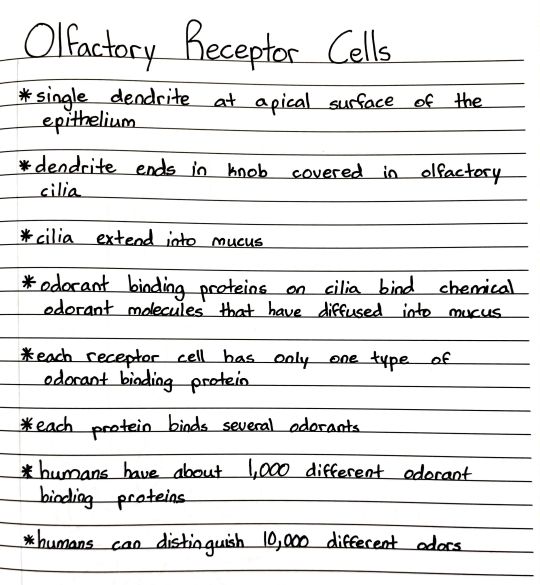
#studyblr#notes#medblr#medical notes#med notes#biology#biology notes#bio#bio notes#olfactory receptor cells#receptor cells#olfaction#human senses#sensory#sensory organs#dendrites#dendrite cells#proteins#epithelium#epithelial cells#epithelial tissue
17 notes
·
View notes
Text
youtube
#2 minute neuroscience#neuroscience#biology#science#cranial nerves#brain#cranial nerve I#olfaction#olfactory nerve#Youtube
1 note
·
View note
Text
Smell is the most lovecraftian sensory modality because it’s primordial, wired directly into paleomammalian processing, non-euclidean in perceptual organization (it’s hyperbolic in state space), poorly linguistically coded, and intimately connected to disease and neurological dysfunction
1 note
·
View note
Text
Dogs Sniffing Out PTSD - Neuroscience News
Summary: Dogs can be trained to detect stress-related volatile organic compounds (VOCs) in human breath, potentially identifying the onset of PTSD flashbacks. This groundbreaking study utilized two dogs to distinguish between the breath of individuals recalling traumatic experiences and control samples, achieving over 70% accuracy.
This finding suggests that assistance dogs could offer earlier…

View On WordPress
#animal psychology#brain research#frontiers#Mental health#neurobiology#Neuroscience#olfaction#Psychology#PTSD
0 notes
Text
Senteurs du Claut : huiles essentielles de laser de France et de mélèze (4/4)
Dans ce dernier opus, je vous propose de découvrir deux huiles essentielles peu connues proposées par les Senteurs du Claut: laser de France Laserpitium gallicum et mélèze Larix decidua.
Dans ce dernier opus, je vous propose de découvrir deux huiles essentielles peu connues proposées par les Senteurs du Claut: laser de France Laserpitium gallicum et mélèze Larix decidua. Le travail que nous avons réalisé sur ces huiles, en les découvrant par le biais de l’olfaction, est encore une fois une preuve que les contours d’une huile peuvent aussi se définir ainsi. Une porte d’entrée vers…

View On WordPress
#aromathérapie sensorielle#huiles essentielles#laser de france#le trek des essentielles#mélèze#Michel Faucon#olfaction#senteurs du claut
0 notes
Photo
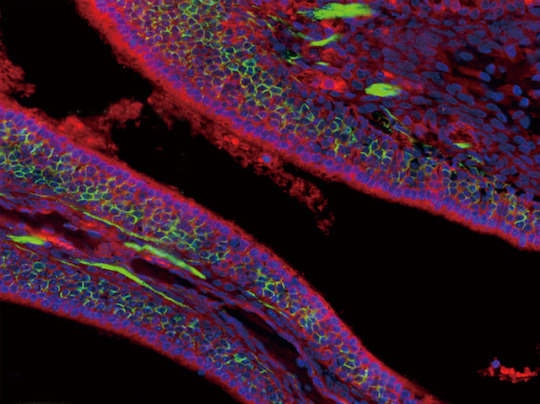
Sniffing Out Symptoms
A loss of taste and smell seems like a relatively innocuous symptom of COVID-19, but it can have lasting impacts on mental health, and is indicative of the virus’ capacity to infect our central nervous system. Researchers interested in the mechanism behind olfactory and neurological COVID consequences examined PHEV, a coronavirus that infects and affects suckling pigs in a similar way. They discovered that PHEV invaded a mouse central nervous system via direct infection of the olfactory nerves (linked to smell) and trigeminal nerves (which provide sensation to your face) in the nose. Through close observation (pictured, cells lining the nasal cavity of an infected mouse, with olfactory neurons in red and cells that bind to PHEV in green) they observed viral material travelling along nerve cells, found links between viral replication and the immune response, and highlighted the potential of this model for learning more about coronavirus infection
Written by Anthony Lewis
Image from work by Junchao Shi and Zi Li, and colleagues
State Key Laboratory for Zoonotic Diseases, Key Laboratory for Zoonosis Research of the Ministry of Education, College of Veterinary Medicine, Jilin University, Changchun, China
Image originally published with a Creative Commons Attribution 4.0 International (CC BY 4.0)
Published in PLOS Pathogens, June 2022
You can also follow BPoD on Instagram, Twitter and Facebook
#science#biomedicine#immunofluorescence#covid 19#covid#sense of smell#sense of taste#olfaction#neuroscience#cns
29 notes
·
View notes
Text
Smelling Pixels: The Emergence of Scent as a Game Mechanic
My very first post as a blogger. Have you ever played a video game and wondered what the level smells like? Probably not, but if you have, then XR tech is here to demonstrate.

View On WordPress
#Cilia#Games#Nosewise#Olfaction#Scent#Smell Engine#Smell-o-Vision#Sony#Technology#VR#first post#writing#writing community
0 notes
Text
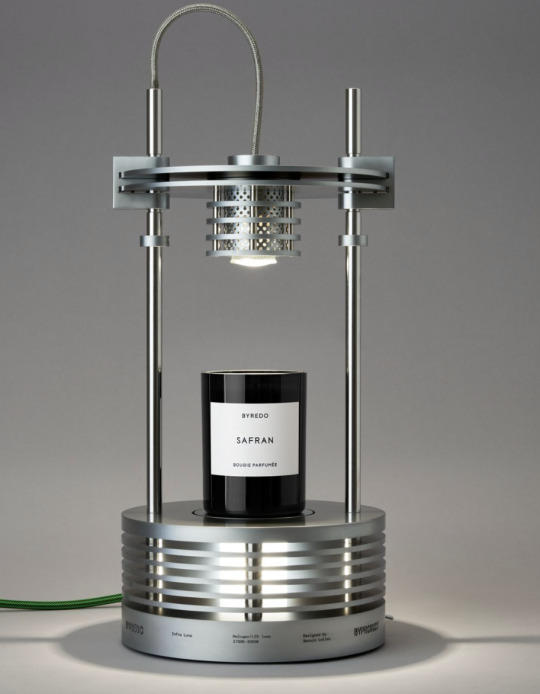

Infra Luna by BYREDO
A limited-edition scent and light diffuser created in collaboration with French designer and light artist Benoit Lalloz. Diffusing both scent and light using an innovative heating mechanism, the hi-tech design is meticulously crafted into a beautiful work of art for the home.
Infra Luna uses heat to melt the wax of Byredo candles into liquid, enveloping the room with the evocative scent. It includes three coloured candle caps in blue, red or chrome, which – when placed over the candle – casts a beautiful wash of light in the colour of choice.
1 note
·
View note
Text
The Amazing Power of the Sense of Smell: Exploring its Impact on Memory, Emotions, Health, and Relationships
Introduction:
The sense of smell, or olfaction, is one of the most powerful and complex senses that humans possess. It is responsible for our ability to detect and distinguish a vast range of scents and odors, and is intimately tied to our memories, emotions, and overall health and well-being. Despite its importance, however, the sense of smell is often overlooked or undervalued in comparison to…

View On WordPress
#aromatherapy#COVID-19#Emotions#Health#olfaction#pheromones#relationships#scent memory#sense of smell
0 notes

